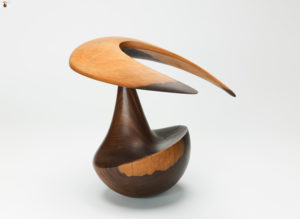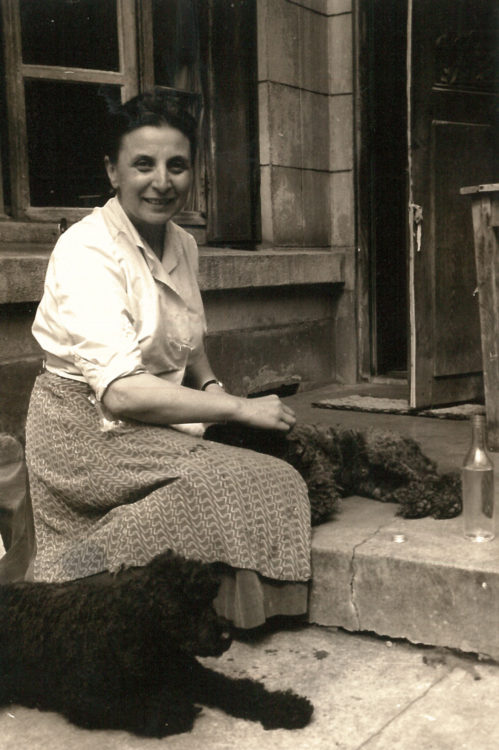Review
Vera Pagava, Paysage ciel bas, 1962, oil on canvas, collection AC/VP, © Association culturelle Vera Pagava
The Musée des Beaux-Arts in Brest is currently presenting the works of six painters and sculptors who arrived in France between 1920 and 1950 and who have in common the theme of exile, whether literal or metaphorical.
A simple partition stands in the middle of the rectangular exhibition hall, at the foot of a flight of stairs. A few short stands guide the eye through the exhibit. Although the forty or so abstract pieces selected by the curator, Marie-Jo Bonnet, seem disparate at first, they are connected by each artist’s decision to leave their home country and begin a career in France during the interwar or post-war years – the contemporary period being the subject of two other matching exhibitions in Rennes.1
The work of Marta Pan (1923–2008), who left Budapest for Paris in 1947, is a compelling example of this. The exhibition contains a selection of small wooden sculptures from the early 1960s, such as Gaiac 2 (1961), which play on the balance of simple shapes smoothly worked into a warm medium. The works of Simone Boisecq (1922–2012), an Algiers-born artist, offer a geometric counterpoint to M. Pan’s biomorphism. Such is the case with Totem (1957), whose title evokes the degree of mysticism the object holds, through a search for modular forms made to guarantee its cosmic reach. In this sense, the exile addressed in the exhibition is not only a matter of geographical space, but also concerns the artists’ mental space, expressed through the use of geometry for Véra Pagava (1907–1988), through the gesturality of Judit Reigl (b. 1923), and through the use of colour for both artists. The juxtaposition of their works is undeniably one of the exhibition’s highlights.
The integration of the artists into the larger network of artists during this specific period is exceptionally dense: the training, exhibitions, and precious support all these artists received seems quite significant. At least this is what one gathers from the information within the exhibition. For example, in a photograph of the students attending the workshop of Antoine Bourdelle (1861–1919), shown at another recent exhibition, it is striking to see the visible diversity of artists; several dozen nationalities are represented, and there are almost as many men as women, most of whom were eventually erased from the canons of twentieth-century art.2
It is this last point which tempers the apparent enthusiasm of the exhibition’s title. While the Parisian art scene could indeed serve as a springboard for artists, it nevertheless remained discriminatory. Feminist critiques in art history are quick to highlight this paradox they have accurately described the strategies these artists developed in return. Sadly the exhibition only touches upon this with a mention of the creation of the group La Spirale by Charlotte Calmis (1913–1982) whose work as an informal painter is also on display.3 The exhibition’s main shortcoming is perhaps its absence of critical discourse, which would encourage us to look beyond each of the artists’ individual trajectories in order to comprehend what is at stake within the very structure of the art historical narrative.
La vraie vie est ailleurs ! Femmes artistes autour de Marta Pan, from 27 June 2019 to 5 January 2020, Musée des Beaux-Arts (Brest, France).
At the Gates, 15 June–25 August 2019, La Criée, contemporary art centre, Rennes ; Créatrices. L’émancipation par l’art, 29 June–29 September 2019, Musée des Beaux-Arts, Rennes.
2
See Boisserolles Claire, Ferrand Stéphane and Simier Amélie (eds.), Transmission/transgression. Maîtres et élèves dans l’atelier : Rodin, Bourdelle, Giacometti, Richier…, exh. cat., Musée Bourdelle, Paris (3 October 2018-3 February 2019), Paris, Paris Musées, 2018.
3
See Fabienne Dumont’s reference historical summary, in which she devotes a chapter to the activities of La Spirale (1972–1982); in Dumont, Des sorcières comme les autres. Artistes et féministes dans la France des années 1970, Rennes, Presses universitaires de Rennes, 2014, pp. 81–91.
Valentin Gleyze, "Women Artists and the Works of Marta Pan: Plural Trajectories." In Archives of Women Artists, Research and Exhibitions magazine, . URL : https://awarewomenartists.com/en/magazine/femmes-artistes-autour-de-marta-pan-trajectoires-plurielles/. Accessed 16 July 2025









